Mostrar el registro sencillo del ítem
El txistu y el tamboril en Navarra
| dc.creator | Aranburu Urtasun, Mikel | es_ES |
| dc.date.accessioned | 2017-11-24T12:40:51Z | |
| dc.date.available | 2017-11-24T12:40:51Z | |
| dc.date.issued | 2012 | |
| dc.identifier.issn | 0590-1871 (Print) | |
| dc.identifier.issn | 2530-5840 (Electronic) | |
| dc.identifier.uri | https://hdl.handle.net/2454/26402 | |
| dc.description.abstract | El conjunto flauta y tambor tocado por un solo ejecutante fue, probablemente, una invención medieval europea que se propagó con celeridad por los reinos cristianos. A Navarra llegó tempranamente a través del Camino de Santiago para dar vida a la danza en la corte y en la plaza. Al decaer en la primera, se asentó en la tradición popular donde ha forjado su propia historia. El músico fue conocido como juglar, tamborino, danbolin o chunchunero hasta su moderna denominación: txistulari. Pese a las continuas medidas represoras por su vínculo con el pecaminoso baile, el oficio de tamborilero aseguró su estabilidad por la institución de la danza de autoridades, su municipalización como soporte y control de las diversiones y de otros servicios públicos y una acreditada habilidad para conjugar tradición y modernidad. Oportunas modificaciones técnicas y una nueva orientación musical, atribuibles al pensamiento ilustrado, lo situaron en las puertas de su actual naturaleza artística y acomodo social. Sin embargo, la moda urbana decimonónica renunció al txistu como instrumento principal para el baile pero lo situó en el patrimonio inmaterial. Tras la última centuria, dinámica y compleja, el txistu suena en el siglo XXI conservando sus rasgos históricos y enriquecido en su esencia musical | es_ES |
| dc.description.abstract | The pipe and tabor played by a single performer was probably a medieval European invention quickly propagated through the Christian kingdoms. It came to Navarre very soon, across the Way of Saint James, and brought life to dance in Court and in the street. When the former decayed, it settled in the folk tradition where it has forged its own history. The musician was called minstrel, tambourine, danbolin or chunchunero until its modern name: txistulari. Despite the continuous repressive measures because of his connection with the sinful dance, the piper assured the stability of the profession thanks to the institution of the dance of authorities, its municipalization as support and control of the diversions and other public services and an accredited ability to combine tradition and modernity. Appropriate technical changes and a new musical direction, attributable to the Enlightenment, placed it at the doors of its current artistic nature and social acceptance. The nineteenth-century urban fashion gave up using txistu as the main instrument for the ball but placed it into intangible cultural heritage. Since the last century, complex and dynamic, the txistu has sounded in the XXIst century preserving its historical features and enriching its musical substance | en |
| dc.format.extent | 66 p. | |
| dc.format.mimetype | application/pdf | en |
| dc.language.iso | spa | en |
| dc.publisher | Gobierno de Navarra. Institución Príncipe de Viana | es_ES |
| dc.relation.ispartof | Cuadernos de Etnología y Etnografía de Navarra, 87 (2012), 5-69 | es_ES |
| dc.rights | Creative Commons Attribution-NonCommercial 4.0 International (CC BY-NC 4.0) | en |
| dc.rights.uri | http://creativecommons.org/licenses/by-nc/4.0/ | |
| dc.subject | Txistu | es_ES |
| dc.subject | Txistulari | es_ES |
| dc.subject | Flauta de tres agujeros | es_ES |
| dc.subject | Danza | es_ES |
| dc.subject | Folclore | es_ES |
| dc.subject | Identidad | es_ES |
| dc.subject | Música popular | es_ES |
| dc.subject | Navarra | es_ES |
| dc.subject | Txistu | en |
| dc.subject | Txistulari | en |
| dc.subject | Three-hole flute | en |
| dc.subject | Dance | en |
| dc.subject | Folklore | en |
| dc.subject | Identity | en |
| dc.subject | Popular music | en |
| dc.subject | Navarre | en |
| dc.title | El txistu y el tamboril en Navarra | es_ES |
| dc.type | Artículo / Artikulua | es |
| dc.type | info:eu-repo/semantics/article | en |
| dc.contributor.department | Derecho Privado | es_ES |
| dc.contributor.department | Zuzenbide Pribatua | eu |
| dc.rights.accessRights | Acceso abierto / Sarbide irekia | es |
| dc.rights.accessRights | info:eu-repo/semantics/openAccess | en |
| dc.type.version | Versión publicada / Argitaratu den bertsioa | es |
| dc.type.version | info:eu-repo/semantics/publishedVersion | en |



